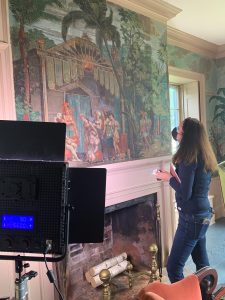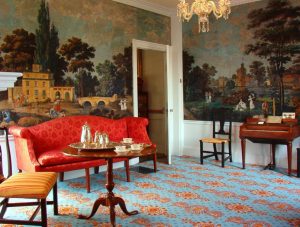King Caesar Wallpaper Conservation
 In October 2021, DRHS obtained the services of Studio TKM Associates, Inc. to do a complete report for future stabilization and preservation of the historic block-printed wallpapers at the King Caesar House Museum.
In October 2021, DRHS obtained the services of Studio TKM Associates, Inc. to do a complete report for future stabilization and preservation of the historic block-printed wallpapers at the King Caesar House Museum.
The papers are fragile, and in many places are suffering from the effects of exposure and loss. This survey provides important steps to ensure that these beautiful papers, which are in both parlors of the historic house, will continue to be preserved for generations to come.
The 1820s papers were installed about 10 years after the house was constructed, and are extraordinary statements on the house’s decor as well as the way the house functioned in terms of social status, business, and public perception. They are absolutely beautiful so be sure to stop by and see them when you are next able!
The DRHS will be working in the next year to obtain the critical funding in order to make the recommendations and improvements. Interested in learning more? Please contact Erin McGough at emcgough@duxburyhistory.org.
Wall paper #1: 
Dufour, Paris, Les Incas, first edition c. 1818. Reissued by Desfosse & Karth, Paris, 2nd half of the 19th c. Printed in color on joined handmade paper sheets in the first edition. Inspired by historian Jean Francois Marmontel’s (1732-1799) Les Incas ou la Destruction de l’empire du Perou (1776) 18th century account of Pizarro’s conquest of Peru in 1531. Produced by Dufour et Cie in 25/30 panels. Collections: Musee des Arts Decoratif de Paris, Victoria & Albert Museum, Kommunkansliet Sweden.
Scene Sequence & Subject
- Panels 1-2: Inca family near tent. Indian corn.
- Panels 3-10 Celebration in the Temple of the Sun. The pineapple and the yucca place the scene in America.
- Panels 11-14 Women presented to Pizarro.
- Panels 15-18 The Cacique spares the life of Gonzales at the request of Las Casas.
- Panels 19-25: Pizarro and his comrades disembark.
Wall paper #2:
Jacquemart, Paris, Le Parc Francais, first edition ca.1820-1925. Printed in color on joined handmade paper sheets. Design borrows from Hippolyte Leconte’s engravings and Pierre Lecompte’s paintings. From right to left, it depicts a peaceful, bucolic scene including the grave of Jean-Jacques Rousseau. Collections: Prestwould, Cortona (Italy), Belgium. As published in Odile Nouvel-Kammerer, French Scenic Wallpaper 1795-1865, Paris, 2001
Scene Sequence & Subject
- Panels 1-4: Tour de Gabrielle
- Panels 5-9: The Farm
- Panels 10-14: The Chinese Bridge
- Panels 15-19: The Chateau d’Ermenonville and the tomb of Jean-Jacques Rousseau
- Panels 20-25: The Guardhouse and the Laure Fountain, inspired by Bourgeois, pl 3. “This building which is used as a guardhouse is the kind of lodge that one sees in certain English parks.”
